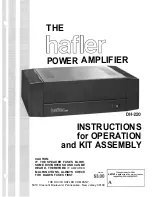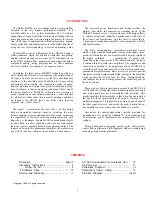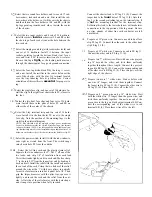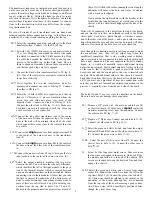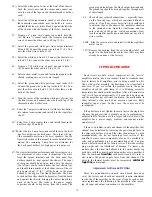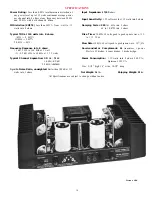
INSTALLATION
The
DH-220
is most likely to be installed out of sight in most
applications, since its power may be controlled by the AC
switching of most audio preamplifiers, like the Hafler DH-110. If
your control unit does not provide switching capacity sufficient
for the amplifier’s 7 amp needs (plus other equipment it is also
switching), you should use the amplifier’s own power switch. In
that case, turn on the preamplifier first; then turn the amplifier
on a few seconds
after
the preamp has been turned on, to avoid
any unnecessary turn-on transients from some preamplifiers.
Likewise, switch the power amplifier off first.
If the amplifier is to be installed close to a record player, you
should first check its position for freedom from hum pickup by
the cartridge from the field radiated by the power transformer
of the DH-220. Although the design of the transformer
minimizes such radiation, certain cartridges are more sensitive
than others, and require separation from the amplifier. Check at
a comparatively high volume setting, and while swinging the
tone arm throughout its arc. Often a few inches additional spac-
ing will eliminate the problem.
Be sure to provide sufficient
ventilation
for the amplifier.
Unobstructed
air circulation
around the finned heat sinks and
above
the amplifier is important for long, trouble-free life. Never
put anything on top of the cover perforations. It is normal for the
top and the heat sinks to become warm in use.
It is expected that the amplifier will always be resting on its
feet, which should be on a hard enough surface that air flow
underneath is not obstructed. If it is mounted in a rack, or
through a panel, the feet may be removed so long as adequate
ventilation is provided through the bottom openings.
OPERATION
The red pilot lamp which is integral with the power switch
glows whenever the amplifier is turned on. A blown AC line fuse
is the most likely cause if it is not illuminated when the amplifier
is switched on.
The pilot lamp also provides a high temperature indication. In
the unlikely event that the amplifier ceases to function, and the
amp blinks on and off steadily, it indicates that one of the ther-
mal breakers has shut down the amplifier because of excessive
temperature rise in a heat sink. When the heat has dissipated in
a few minutes, the amplifier should return to normal operation.
If the lamp again blinks, check for insufficient ventilation, or an
excessive input signal, or an input which may have dangerous
signal content (such as oscillation). Failing evidence of this, the
amplifier may have malfunctioned. Because of the very large
heat sinks, it is highly unlikely that any normal signal will cause
the amplifier to overheat.
Loudspeaker Fuse Selection
The DH-220 power amplifier is supplied with 2 amp fuses in
the speaker lines. Experience has shown that since an overload
must exist for a few seconds for a fuse to blow, a 2 amp fuse will
protect most speaker systems, and only blow when overload oc-
curs. Smaller fuses tend to blow too easily, and larger fuses do
not adequately protect most speaker systems.
A pair of 5 amp fuses are also supplied as alternatives for the
speaker fuse holders. These should be substituted if the power
output of the amplifier is to be tested, and these or intermediate
values may be used if the amplifier is to be operated at very high
power levels into 4 ohm loads.
If the manufacturer of your speakers recommends a specific
value of fuse for their protection, we suggest that you obtain
A C fuses of that value and install them in the back panel.
Loudspeaker Power Ratings
There are no U.S. standards for rating the power handling of
loudspeakers. As a result, the manufacturers’ usual “music
power” ratings, or suggested amplifier limits, are of only
minimal help in determining safe operating levels with
amplifiers which can deliver substantial amounts of power. You
must take into consideration the type of music, and the levels
you like, to provide long term trouble-free operation of your
speaker choice, when you have a sizeable amplifier like the
DH-220.
Connections
AC
The AC power cord should be plugged into 120 volts, 60 Hz,
on the switched outlet of a preamplifier which can provide at
least 7 amps, or 840 watts. Then the amplifier power switch may
be left on, and it will be controlled by the rest of the system. Or. it
may be plugged into a 120 volt wall outlet, and switched on and
off independently.
If your line (mains) voltage is different, be sure you have the
alternate power transformer which can accommodate several
line voltages, and be sure it is wired for your mains voltage as
described later in this manual
before you pIug in the amplifier.
Input
Conventional shielded cables, such as those supplied with
your preamplifier, provide the input signal to the sockets on the
back panel of the DH-220. Be sure that the outer shield connec-
tion is secure, to avoid hum. The length of these cables (so as to
permit remote location of the amplifier, if desired) is limited only
by the output impedance of the preamplifier. If it is 600 ohms or
less, as with the
DH-101
and DH-110 Hafler preamps, for in-
stance, cable lengths up to 50 feet are premissible without loss of

